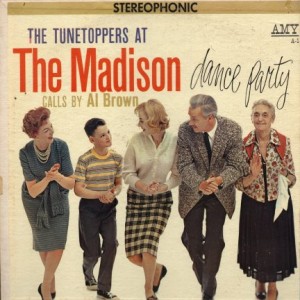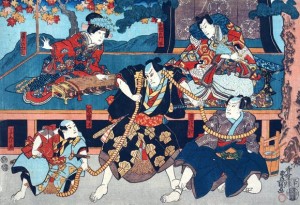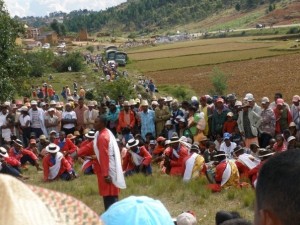The Multi-User Dance and Socialization
by RadiumEyes, HSM team writer
Dance.
The dance, whatever form it may take, occupies a special place in human society – for thousands of years, people performed dances for various reasons, from rituals (e.g., the Ghost Dance, where the living can communicate with the dead) to social gatherings (e.g., the sock hop of the 1950s). Anthropology has its own discipline, ethnochoreology, dedicated to the study of dance; although I never studied ethnochoreology, my anthropological background helped tremendously in applying scientific thought to cultural phenomena.
PlayStation Home offers its own microcosm of dancing, and one would be remiss to not discuss the overarching theme of social interaction attendant to it; with the introduction of eight-user dance LMOs (courtesy of Lockwood), we now have a larger repertoire to examine. Bear with me here – I haven’t written an anthropology-focused paper in some time, so this may be more social in scope. Still, the Lockwood multi-person LMOs offer a new social and cultural context of play on Home, where people can engage in a social gathering through a shared interest. With that in mind, let’s look at the general trends of dancing on Home.
Anthropological examinations of the dance go back decades; Evans-Pritchard, in his article entitled “The Dance,” compared the styles of music and movement between European and African dances, with a particular focus on the Zande people, a Central African ethnic group. According to Evans-Pritchard in this 1928 article, dance was a joint activity – his observations of the Azande emphasized the importance of the group effort. Importantly, he argues in favor of studying the dance as an important sociological function; he mentions its marginalization in anthropological literature, and through the article, he wished to bring dancing to the anthropological forefront as an integral part of society. Since then, we’ve come to appreciate it, and a greater effort to integrate the activity into studies means that dancing’s social value (through an anthropological lens) grew over time.
PlayStation Home’s various dance moves (or, if we take Adrienne Kaeppler’s term, “structured movement,” which she used in the context of observing Tongan groups) reflect a Western value of the dance as a specific form of structured movement; Kaeppler, in her 1983 article “Structured movement systems in Tonga,” argues that the term “dancing” refers to a Western perspective, which may not adequately cover other forms of movement such as ice skating. Bear in mind that Kaeppler introduced the phrase “structured movements” as a more inclusive means of describing various cultural forms of movement that may not adhere strictly to a “dance” framework.
 Whatever your take on dancing may be, Lockwood’s recent LMO offerings present a group-oriented structure of movement, with modern Western dances as the focus – they specifically mention ItchyHeini and his four different accounts, dancing in unison, when they introduced the Party Dance Pack on their homepage. The Party Dance Pack thus stems partially from a famous user and his coordinated movements that Home veterans would recognize; Lockwood pay homage to the man and his dedication by allowing people to do the same thing with their own avatars, streamlining the process and offering a wonderful way of having users enjoy Home through a shared experience.
Whatever your take on dancing may be, Lockwood’s recent LMO offerings present a group-oriented structure of movement, with modern Western dances as the focus – they specifically mention ItchyHeini and his four different accounts, dancing in unison, when they introduced the Party Dance Pack on their homepage. The Party Dance Pack thus stems partially from a famous user and his coordinated movements that Home veterans would recognize; Lockwood pay homage to the man and his dedication by allowing people to do the same thing with their own avatars, streamlining the process and offering a wonderful way of having users enjoy Home through a shared experience.
Home’s informal gatherings do not have the exact same rituals, but people gather primarily for fun – the Party Dance Park brings them together in a novel way, with the first LMO that up to eight people can activate simultaneously. Such socializations do not adhere to the same level of ritual that one would see in royal engagements, yet they have their own unique purposes. Humans are social animals, and such events reinforce the value of group activity; people enjoy the company of friends, which dance facilitates. By introducing an LMO that allows for a larger group to participate in, Lockwood paved the way for a potential wave of similar “structured movements” that encourage socialization; at the same time, its success illustrates the seemingly ingrained human desire to socialize, to be part of a greater cultural dynamic where everyone is welcome. The two-person LMOs that preceded it (which include the ability to kiss or hug others, as well as dance on a more personal level) showed the possibility of such interactions, and Lockwood took it a step further – now we have a means of including several friends in a fun little dance, following in the footsteps of ItchyHeini and his coordinated avatars.
Home still has plenty of life left in it, and the inclusion of such LMOs lets users see the potential it still has. Even after six years of open beta, developers explore new and important avenues of entertaining crowds without feeling intrusive. These new LMOs are entirely voluntary, and people can exit them at any time – that they sold well (at least, decently so) indicates a receptive audience who enjoys getting together to have a fun moment.
Now, this opens up a new question – what if developers could pursue other structured movements, such as ice skating and the veritable kabuki play? Kaeppler raises the point that “dancing,” in Western parlance, seems to have its limitations – kabuki acting would not be included in the definition, despite a ritualized movement that suggests a dancing atmosphere. In fact, kabuki’s three kanji respectively stand for “sing,” “dance” and “skill,” encapsulating the theatrical tradition; two main dance styles exist in the art form, monomane (an archetypal character style of movement) and mitate (where a hand prop substitutes for something else). The latter term also refers to a method of criticism, where present events have a past parallel; actors could criticize the ruling class through the “double meaning” of dramatizing a historical moment that paralleled current events.
Ice skating already has representation on Home, but what about having a two-player skating pack emulating movements that require two people to perform? Skating tournaments include numerous two-person teams working in tandem, so this could be a great way of bringing the activity into the fold. As for kabuki, this may be more complicated; both individual and paired movements can be done, but each movement has a specific meaning. Of note are the fighting scenes, known as tachimawari, a stylized form of acting with special movements each actor performs. Translating this to an LMO may take some work, since kabuki plays usually last a few hours, and movements are slower compared to popular dances (such as the various dance trends that made the rounds in the 1950s) – yet, this would be really fun to try out. Imagine having a multi-player LMO that plays out like a play in miniature.
The same could be applied to numerous dances, such as the channa upuli of Sri Lanka – Lockwood introduced the Bollywood dance pack earlier this year, which opens up more avenues for traditional and popular dances from other countries. Western styles and K-pop work wonderfully, but some more diversity would be great for consumers. The eight-person group dance (inaugurated by Lockwood) can bring some more complex group dances to digital life, and that would be a great asset; the world is a diverse place, and Home would do well to represent various cultures. Dance is a universal concept, and Lockwood has something here that would allow for more movements.
Share
| Tweet |




 Twitter
Twitter